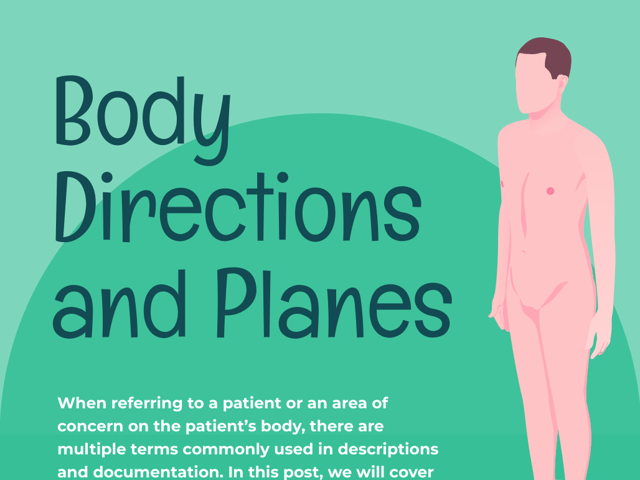
Body Directions and Planes
When referring to a patient or an area of concern on the patient’s body, there are multiple terms commonly used in descriptions and documentation. In this post, we will cover four common body direction pairs and four common body planes.
Body Directions
Body directions are grouped in pairs of opposing directions. These terms can relate to the entire body or something’s position relative to another anatomical structure, like where a mole is on a client’s back relative to the spine.
Anterior/Posterior
Anterior refers to the front of the body or something that is in front of another structure, and posterior refers to the back of the body or something that is behind another structure. For example, glute muscles are on the posterior side of the body, while hamstrings are both on the anterior side of the body and also anterior to the glute muscles.
Superior/Inferior
Superior refers to something that is toward the client’s head while inferior refers to something away from the head. As an example, the heart is in the superior half of the body but inferior to the skull.
Distal/Proximal
This direction typically refers to limbs, with distal being the direction away from the joint and toward the extremities and proximal being the direction toward the joint and away from the extremities. For example, the wrist is distal to the elbow and proximal to the fingers.
Medial/Lateral
These directions are relative to the midline of the body. Something that is medial is toward the midline of the body, and something that is lateral is away from the midline of the body. As an example, the oblique muscles are lateral to the umbilicus, and the nose is medial to either ear.
Body Planes
When thinking about body planes, it may be easiest to imagine a sheet of glass splitting the body into two halves.
Sagittal
The sagittal plane is a vertical plane that separates the body into a left half and a right half. The plane goes from top to bottom vertically.
Frontal
The frontal plane is another vertical plane, but this separates the body into an anterior (front) side and posterior (back) side.
Transverse
The transverse plane is a horizontal plane that separates the body into a superior (top) half and an inferior (bottom) half.
Oblique
Oblique planes are any planes that separate the body but that are not vertical or horizontal. For example, a plane from the right shoulder to the left hip would be an oblique plane.

Keep Reading

National Council Licensure Examination-Registered Nurse Blog
What to Expect in Nursing School Clinicals
The clinical experience is a rite of passage for all nursing students, …

National Council Licensure Examination-Registered Nurse Blog
What is the NCLEX Next Generation (NGN) Exam?
If you’re interested in becoming a registered nurse, you likely know th…

National Council Licensure Examination-Registered Nurse Blog
IDEA for Drugs to Treat Bradycardia/Hypotension
For hospitalized patients, bradycardia (slow heart rate) and hypotensio…